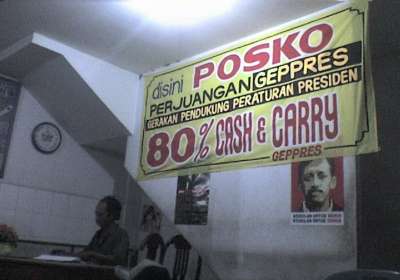korbanlumpur.info – Sorak sorai langsung terdengar ketika Suwito, perwakilan warga yang masuk dan ditemui bupati keluar dan menyampaikan hasil pertemuan di pendopo Kabupaten Sidoarjo. Korban lapindo sudah beberapa kali harus berdemo ke Bupati untuk mempertanyakan nasibnya, juga beberapa kali sudah sujud syukur ketika tuntutan mereka seolah terpenuhi, dan mereka sudah lelah ditipu, lalu, apalagi yang baru sekarang?
Siang itu (05/08/2008), matahari sudah bergeser dan warga yang menunggu di luar pendopo kabupaten masih bertanya-tanya dalam hati, apakah betul asset tanah warga yang Petok D dan Letter C bisa di-AJB-kan, yang artinya bisa mendapatkan ganti rugi secara cash and carry? Sementara di dalam, Perwakilan warga yang ditemui Bupati menyampaikan segala harapan dan tuntutannya.
Dengan membawa sebendel bukti berisi peraturan-peraturan dan risalah rapat serta komitmen pihak-pihak terkait, warga mengadu dan meminta Bupati merespon tuntutan warga untuk segera dibayar ganti rugi asset mereka secara cash and carry. Sudah lama mereka diombang-ambingkan dan digoyang isu-isu dan informasi yang tidak jelas. Pihak Minarak lapindo Jaya setelah melaukan pertemuan dengan GKLL menyatakan tidak akan melaksanakan pembayaran dengan pola cash and carry kepada warga korban lumpur yang bukti kepemilikan petok D/letter C/SK Gogol dalam kondisi dan situasi apapun (tempointeraktif, 26 Juni 2008).
Pasca pernyataan itu, tentu saja korban lumpur yang mayoritas memiliki bukti asset berupa Petok D dan Letter C resah, tidak ada angin tidak ada hujan mereka yang sudah berharap segera menerima sisa ganti rugi 80% karena masa kontrakannya habis kembali menelan pil pahit. Jika sebelumnya mereka melalui GKLL giat menuntut cash and carry, namun akhirnya cash and resettlement yang didapat.
Pihak Minarak lapindo Jaya berkilah bahwa pemilik asset dengan bukti kepemilikan Petok D dan Letter C tidak bisa di-AJB-kan. Padahal Badan Pertanahan Nasional sudah mengeluarkan surat pada tanggal 24 Maret 2008 mengenai mekanisme AJB untuk semua bukti kepemilikan (Sertifikat, Petok D, Letter C, SK Gogol, Yasan serta tanah asset Pemda dan yang berstatus HGB). Belum lagi jika merujuk pada banyak risalah rapat dan komitmen yang bukan hanya ditanda tangani Andi Darusalam selaku Vice President PT Minarak lapindo jaya tetapi juga pejabat negara baik daerah maupun pusat, yang jelas menyatakan bahwa Petok D, Letter C dsb diperlakukan sama dengan sertifikat dan berhak mendapat ganti rugi yang sama.
Namun semua itu seolah menguap, dan komitmen yang ditanda tangani seolah tidak ada. Lalu, pada tanggal 25 Juni 2008, keluarlah pernyataan itu: ʽPT MLJ tak akan melaksanakan pembayaran dengan pola cash and carry kepada warga korban lumpur yang bukti kepemilikan petok D/letter C/SK Gogol dalam kondisi dan situasi apapunʼ Perih dan menyakitkan!’
Namun, sorak-sorai pada 5 Agustus 2008 di depan Pendopo Kabupaten kemarin seolah memberikan titik cahaya kepada mereka yang memilih untuk tetap menuntut hak mereka secara cash and carry. Bupati Sidoarjo, Badan Pertanahan Nasional, dan Badan Penanggulangan Lumpur Sidoarjo menyatakan bahwa semua asset warga dengan bukti kepemilikan Petok D, Letter C, SK Gogol bisa di-AJB-kan dan Pihak lapindo harus menunaikan kewajibannya membayar sisa ganti rugi 80% secara cash and carry.
Bukan akhir dari segalanya memang, masih butuh perjuangan untuk tetap menuntut tanggung jawab Lapindo dalam mengganti rugi asset warga yang telah tenggelam. Mereka mengepalkan tangan dan berteriak mengungkapkan kegembiraannya. Bapak-bapak dan kaum muda meloncat-loncat mengekspresikan kelegaannya, beberapa ibu terlihat menangis terharu mendengar berita itu. Harapan itu masih ada dan terjaga, harapan untuk mendapatkan lagi kehidupan mereka yang telah ditenggelamkan oleh Lapindo baik dengan lumpur maupun dengan tindakan-tindakan mereka yang mengingkari hak-hak warga.
Sorak sorai itu terdengar optimis, kelegaan yang menyeruak setelah kegundahan akan terbayarnya aset mereka terjawab. Tapi perjuangan tidak boleh hanya berhenti pada kelegaan.

